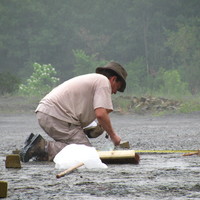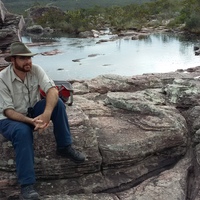Papers by Snæbjörn Pálsson
Animal conservation, Mar 17, 2024
Annals of Botany, Jan 26, 2007
Molecular Ecology, Aug 1, 2000

Molecular Ecology, Dec 1, 1996
We studied sequence variation of a fragment of the mitochondrial cytochrome b gene using polymera... more We studied sequence variation of a fragment of the mitochondrial cytochrome b gene using polymerase chain reaction (PCR) and direct sequencing among 85 Norwegian Atlantic cod Gadus morhua, from nine sampling localities representing three overall areas: arctic, coastal and middle. In the analysis we include an additional 15 cod studied by Carr & Marshall (1991a). Nine base changes were found among the 100 sequences defining 11 haplotypes which differ from each other by one to five mutations. Two sites have been hit twice. All but one mutation are at third position silent sites. The variation passes several neutral‐theory tests and is thus suitable as marker for studying population differentiation. Coefficients of coancestry or intraclass correlation coefficient are negative both at the level of individuals within localities and localities within areas. This implies greater differences among individuals within populations than between populations. Intralocality nucleotide diversity is high and masks interlocality nucleotide divergence such that the net interlocality nucleotide divergence is nil. Similarly the net interarea nucleotide divergence is nil.

Molecular Ecology, 2004
Extensive sharing of chloroplast haplotypes among the silver birch, Betula pendula Roth., the dow... more Extensive sharing of chloroplast haplotypes among the silver birch, Betula pendula Roth., the downy birch, B. pubescens Ehrh., and the dwarf birch, B. nana L., was discovered using polymerase chain reaction–restriction fragment length polymporphism markers. The geographical component of the genetic variation was stronger than the species component: the species were not significantly different while 11% of the variation could be attributed to differentiation between the two main regions studied, Scandinavia and western Russia. All haplotypes occurring in more than 2% of the individuals were shared among the species and the introgression ratios were quite large: 0.79 between B. pubescens and B. pendula and 0.67 between B. pubescens and B. nana. The data also indicate that B. pendula individuals are more similar to sympatric B. pubescens than to B. pendula individuals from nearby forests. However, this trend is not as pronounced when B. pubescens is considered, suggesting that introgression is not symmetrical. The haplotype sharing among the three Betula species is most likely caused by hybridization and subsequent cytoplasmic introgression.
Zoosymposia, Jun 12, 2020

Ibis, Jun 14, 2022
Yearly electricity production has increased steadily worlwide in recent decades and the associate... more Yearly electricity production has increased steadily worlwide in recent decades and the associated overhead power lines are widespread and occur across urban and natural habitats, and often in remote areas where there is little other anthropogenic influence. Here we assessed the effects of overhead power lines on the density of ground‐nesting birds in the Icelandic lowlands, which host several populations of international importance. The combined breeding density of the eight study species increased significantly from ~ 112 birds/km2 close (< 50 m) to the power lines to ~ 177 birds/km2 away (450–500 m) from the power lines, with two of these species (Eurasian Whimbrel Numenius phaeopus and Common Redshank Tringa totanus) increasing significantly with distance from power lines and six species (European Golden Plover Pluvialis apricaria, Common Snipe Gallinago gallinago, Meadow Pipit Anthus pratensis, Black‐tailed Godwit Limosa limosa, Dunlin Calidris alpina and Redwing Turdus iliacus) showing no changes. These findings suggest that power lines can influence the breeding density of ground‐nesting bird species in their vicinity and that accounting for such effects when planning future infrastructure will be imperative.
Aquaculture, Dec 1, 1994
ABSTRACT Sequence variation was detected by polymerase chain reaction (PCR) and direct sequencing... more ABSTRACT Sequence variation was detected by polymerase chain reaction (PCR) and direct sequencing of a 295-nucleotide region of the mitochondrial cytochrome b gene of Arctic charr (Salvelinus alpinus), Atlantic salmon (Salmo salar) and brown trout (Salmo trutta) sampled around Iceland. Four haplotypes were found within Atlantic salmon, no variation was found within Arctic charr or brown trout. Synonymous substitution rates among the species were according to a molecular clock. There was a significant transition/transversion bias but apparent transitional bias among purines and pyrimidines was not significant, given permissible mutations which would not alter the amino acid sequence. The amino acid sequences were identical among the species where intraspecific variation did not exist.
Nature Communications, Nov 25, 2021
Journal of Biogeography, Jul 2, 2010
Journal of Heredity, 2002
Marine Biotechnology, Jan 24, 2008
A noncoding intergenic spacer has previously been reported in mtDNA of Gadiformes. Here we presen... more A noncoding intergenic spacer has previously been reported in mtDNA of Gadiformes. Here we present sequence information from two other cod species and variation within three species to clarify the evolution of this region. A general feature of the T-P spacer is high variation and folding into two or three hairpins. The variation among species both in structure of the region and sequence variation reflects the phylogenetic relationship of the species. A unique pattern is found within Arctic cod, Arctogadus glacialis, in which tandem repeat motifs result in new stable secondary structures. There is large variation in size of the region both within (heteroplasmy) and among individuals. A duplicated insertion is found in Greenland cod, Gadus ogac, at the same position as a corresponding duplication in Atlantic cod, Gadus morhua.
Molecular Ecology Notes, Jan 6, 2004

Molecular Ecology, Oct 24, 2012
According to the inclusive fitness theory, some degree of positive relatedness is required for th... more According to the inclusive fitness theory, some degree of positive relatedness is required for the evolution and maintenance of altruism. However, ant colonies are sometimes large interconnected networks of nests, which are genetically homogenous entities, causing a putative problem for the theory. We studied spatial structure and genetic relatedness in two supercolonies of the ant Formica exsecta, using nuclear and mitochondrial markers. We show that there may be multiple pathways to supercolonial social organization leading to different spatial genetic structures. One supercolony formed a genetically homogenous population dominated by a single mtDNA haplotype, as expected if founded by a small number of colonizers, followed by nest propagation by budding and domination of the habitat patch. The other supercolony had several haplotypes, and the spatial genetic structure was a mosaic of nuclear and mitochondrial clusters. Genetic diversity probably originated from long-range dispersal, and the mosaic population structure is likely a result of stochastic short-range dispersal of individuals. Such a mosaic spatial structure is apparently discordant with the current knowledge about the integrity of ant colonies. Relatedness was low in both populations when estimated among nestmates, but increased significantly when estimated among individuals sharing the same genetic cluster or haplogroup. The latter association indicates the important historical role of queen dispersal in the determination of the spatial genetic structure.

Journal of Fish Biology, Feb 1, 2000
Sequence variation of a 250–bp (base pair) fragment of the mitochondrial cytochrome b gene has be... more Sequence variation of a 250–bp (base pair) fragment of the mitochondrial cytochrome b gene has been studied using polymerase chain reaction and direct sequencing of 519 Atlantic cod Gadus morhua from Iceland and 78 cod from Greenland. Twenty‐four variable nucleotide sites, mostly silent, define 34 haplotypes. The amount of variation is high (?C=0·73, π=0·52 per 100 bp) with five haplotypes at polymorphic frequencies in Iceland and a number of widely dispersed rather rare haplotypes. A tree of genetic relationships among haplotypes has considerable homoplasy yet it is relatively shallow implying a high turnover of variants of the polymorphism. Net nucleotide genetic divergences among localities are nil. Geographic locality overall area, and inshore/offshore comparison explain none of the variation in an AMOVA, all the variation is among individuals and a null hypothesis of non‐differentiation of haplotype frequencies among localities or overall areas cannot be rejected. A temporal year‐class effect is found. The evolutionary difference between Greenland and Iceland cod is not significant and the percentage of variation accounted for by the Greenland/Iceland difference is half of what a temporal effect within Iceland explains. There is no evidence for considering the cod at Greenland and Iceland to consist of separate evolutionary units and the question of separate management units must address the lack of diagnostic genotypes and evidence for gene flow from clinal variation.
Authorea (Authorea), Jul 12, 2021

Journal of Fish Biology, Sep 20, 2012
Two pairs of sympatric three‐spined stickleback Gasterosteus aculeatus morphs and two single morp... more Two pairs of sympatric three‐spined stickleback Gasterosteus aculeatus morphs and two single morph populations inhabiting mud and lava or rocky benthic habitats in four Icelandic lakes were screened for parasites and genotyped for MHC class IIB diversity. Parasitic infection differed consistently between G. aculeatus from different benthic habitats. Gasterosteus aculeatus from the lava or rocky habitats were more heavily infected in all lakes. A parallel pattern was also found in individual MHC allelic variation with lava G. aculeatus morphs exhibiting lower levels of variation than the mud morphs. Evidence for selective divergence in MHC allele number is ambiguous but supported by two findings in addition to the parallel pattern observed. MHC allele diversity was not consistent with diversity reported at neutral markers (microsatellites) and in Þingvallavatn the most common number of alleles in each morph was associated with lower infection levels. In the Þingvallavatn lava morph, lower infection levels by the two most common parasites, Schistocephalus solidus and Diplostomum baeri, were associated with different MHC allele numbers.

Journal of Theoretical Biology, 2001
Cyclically parthenogenetic organisms experience benefits of both sexual and asexual reproductive ... more Cyclically parthenogenetic organisms experience benefits of both sexual and asexual reproductive modes in a constant environment. Sexual reproduction generates new genotypes and may facilitate the purging of deleterious mutations whereas asexuality has a two-fold advantage and enables maintenance of well-fitted genotypes. Asexual reproduction can have a drawback as increased linkage may lead to the accumulation of deleterious mutations. This study presents the results of Monte Carlo simulations of small and infinite diploid populations, with deleterious mutations occurring at multiple loci. The recombination rate and the length of the asexual period, interrupted by sexual reproduction, are allowed to vary. Here I show that the fitness of cyclical parthenogenetic population is dependent on the length of the asexual period. Increased length of the asexual period can lead both to increased segregational load following sexual reproduction and to a stronger effect of deleterious mutations on variation at a linked neutral marker, either by reducing or increasing the variation.











Uploads
Papers by Snæbjörn Pálsson